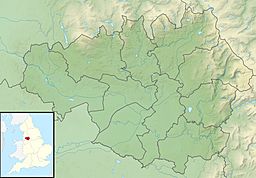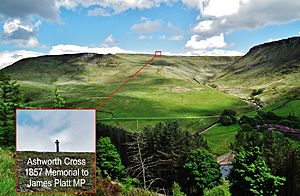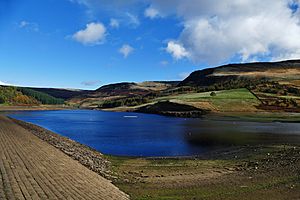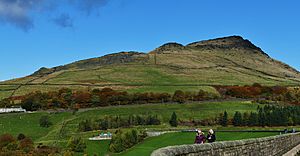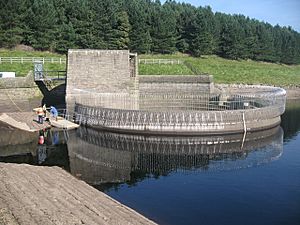Dovestone Reservoir facts for kids
Quick facts for kids Dovestone Reservoir |
|
|---|---|
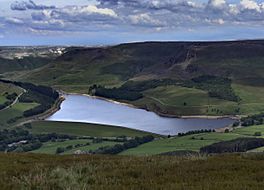
Dovestone from Alphin Hill
|
|
| Location | Greenfield Greater Manchester England |
| Coordinates | 53°31′48″N 1°58′30″W / 53.530°N 1.975°W |
| Lake type | reservoir |
| Primary inflows | Greenfield Brook Chew Brook |
| Primary outflows | Chew Brook |
| Basin countries | England |
Dovestone Reservoir is a large lake found where the Greenfield and Chew Brooks meet. It is located above the village of Greenfield in Greater Manchester, England. This beautiful reservoir sits on the western edge of the Peak District National Park. It provides clean drinking water to nearby towns and is a popular spot for visitors. Many people enjoy walking along its paths and taking in the lovely views.
Contents
History of Dovestone Reservoir
Early Buildings and Memorials
In 1850, a man named John Platt built a grand house called Ashway Gap. It was designed in a style called Neo-Gothic, which looks like old castles. This house was used for hunting trips. However, after his brother James died in a hunting accident nearby, the house was left empty.
Later, a group called the Ashton-under-Lyne, Stalybridge and Dukinfield Waterworks Joint Committee bought the house. This committee was in charge of providing water. During World War I, they even offered the house to be used as a hospital. The house was eventually taken down in 1981. You can still find old boundary stones along the footpaths on the south side of the reservoir. These stones show where the original estate ended.
Above Ashway Gap, there is a stone called the Ashway Stone. It is a memorial to James Platt, who was a Member of Parliament (MP) for Oldham. He sadly died when a gun accidentally went off.
Building the Reservoir
The plan to build reservoirs in the Greenfield Valley and Chew Valley started in 1870. The Ashton-Under-Lyne, Stalybridge and Dukinfield Waterworks Joint Committee led this big project. Dovestone Reservoir was the last part of this plan, finished in 1968. Its main job was to collect water from the surrounding moorland.
Some local factory owners were worried that building the dam would stop their water supply. To solve this, a special tunnel was built higher up the hillside. This tunnel allowed water to flow around the reservoir, making sure the factories still had enough.
Geography of Dovestone Reservoir
Dovestone Reservoir is located where the Greenfield and Chew Brooks meet. It is above the village of Greenfield. This area is on the north-western edge of the Peak District's Dark Peak region.
Dovestone is the lowest and largest of three reservoirs in the Greenfield Valley. Above it, you will find Yeoman Hey Reservoir, built in 1880, and then Greenfield Reservoir. In the upper Chew Valley, there is Chew Reservoir. When it was built in 1914, Chew Reservoir was the highest reservoir in the British Isles, sitting 488 metres (1,600 feet) above sea level.
The reservoirs are surrounded by open moorland and tall, rocky hills. The A635 road, which goes to Holmfirth, passes to the west and north of these reservoirs.
The Dovestone Dam
The Ashton under Lyne, Stalybridge & Dukinfield Joint Committee got permission to build the reservoir in 1958. Work on the dam began in 1960 and was completed in October 1966.
Dam Structure
The dam is made of earth and is 38 metres (125 feet) high. It stretches 550 metres (1,800 feet) across the valley. At its widest point at the bottom, it is 183 metres (600 feet) wide. To stop water from leaking, a concrete wall goes 23 metres (75 feet) deep into the ground. Above this concrete wall is a core made of clay. Dovestone Dam is thought to be one of the last large dams in Britain built with this traditional clay core. The dam itself contains a huge amount of material, about 34,000 cubic metres.
Water Control
Unlike many dams, Dovestone does not have a traditional spillway (a channel for water to flow over). Instead, it has a large, bell-shaped overflow in one corner. This "bell-mouth" sends excess water into a tunnel under the side of the valley. This type of overflow is not common on dams in the Pennine hills, which usually have stone spillways.
There is also a clever emergency overflow system on the dam wall. It has three metal troughs that fill with water. When full, they tip the water over a wall, and it flows across the road and back into the river below. This emergency system kicks in if there is a sudden flood of about two metres of water.
Recreation at Dovestone Reservoir
Dovestone Reservoir is a popular place for outdoor activities. You can get to the reservoir by using the A635 road, where there are pay and display car parks. Toilets are available at Binn Green and at the main car park. The Peak District Park Ranger Service has an office near the main car park. Rangers are often seen patrolling the area on weekends, helping visitors and keeping the park safe.
Activities
The reservoirs and the surrounding moorland are great for walkers and hikers. Many people enjoy jogging, and there is even a race held every Friday evening during the summer months. The path around Dovestone is well-kept, covered in gravel, and mostly flat, making it easy to walk or run.
From the main circular path, you can find other routes. These paths lead to Chew Reservoir, towards the car park at Binn Green, and along the Greenfield Valley past the Yeoman Hey and Greenfield Reservoirs.
The Dovestone Sailing Club uses the reservoir for sailing. The Chew Valley area is also known for its gritstone rocks, which attract climbers and boulderers (people who climb on large rocks).
Conservation and Community
Since 1999, a project called "Life for a Life" has allowed people to plant a tree in memory of a loved one. More than 700 trees have been planted as part of this special program.
In 2010, the Royal Society for the Protection of Birds (RSPB) became interested in the area. They now help manage the surrounding moorland and woodland, working with United Utilities, the company that manages the water.
The Peak District Boundary Walk, a long-distance walking trail, also runs along the path on the dam's embankment.


